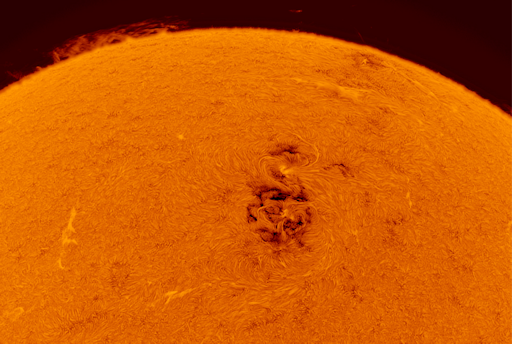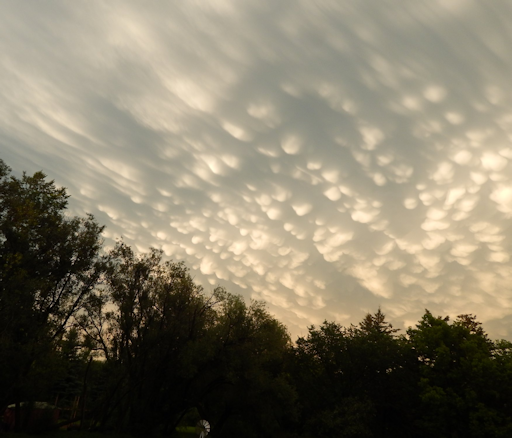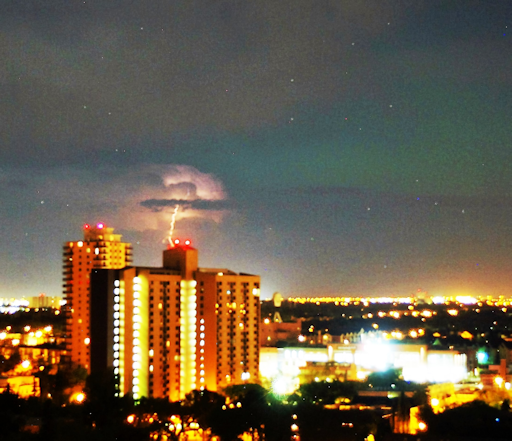It's waiting for you: The most successful Aurora Photo Tour on Earth! 100% success rate 4 years in a row and winner of the TripAdvisor Certificate of Excellence Award. Join LapplandMedia's aurora tours in Abisko, Swedish Lapland! | | | NOCTILUCENT CLOUDS TONIGHT? Hours ago, photographer Andy Stables of Scotland reported a very bright display of noctilucent clouds--"the best show of the year so far here on the Isle of Skye," he says. Sky watchers in North America should be alert for a similar apparition as night falls over their continent. High-latitude observing sites such as Canada and northern-tier US states are favored. [photo gallery] SOLAR ACTIVITY INTENSIFIES (UPDATED): Sunspot complex AR2565-AR2567 is crackling with M-class solar flares as magnetic fields threading the behemoth active regions stretch, twist, and re-connect. Mike Taormina photographed the sunspots' seething cores from his backyard observatory in Malta, New York: 
"The sun was alive with activity today!" says Taormina. "I am constantly amazed at the impressive level of detail that a small solar telescope can capture under good seeing conditions." Update: A series of explosions crossing the July 20-21 UT day boundary hurled two CMEs away from the sun's southwestern limb. Coronagraph images from SOHO show that the clouds are not heading directly for Earth. Nevertheless, glancing blows to our planet's magnetic field may be possible in 2 to 3 days. NOAA analysts are modeling the CMEs trajectory now. Stay tuned for storm tracks. Realtime Space Weather Photo Gallery AFTER THE STORM, MAMMATUS CLOUDS: Yesterday, a severe thunderstorm swept through St Claude, Manitoba, drenching the landscape and cutting power to residents. "While waiting for power to be restored, I noticed these cloud formations drifting serenely overhead," reports Paul Moffat. "It seemed to make the storm's fury worthwhile." 
These are mammatus clouds. Named for their resemblance to a cow's underbelly, they often appear around the unstable edges of severe thunderstorms. Researchers have called mammatus clouds an "intriguing enigma," because they have not been studied as much as other clouds, and there is much uncertainty about how they form. Photographers and artists have long valued mammatus clouds for their strangely beautiful appearance. Indeed, Gedzelman (1989) notes that the pendulous lobes appear in paintings as early as the 1500s. Mammatus clouds often go unnoticed because potential observers have been chased indoors by the rain. If you are one of them, go back outside when the downpour stops; you could witness a beautiful mystery in the sky. Realtime Space Weather Photo Gallery CME IMPACT SPARKS SUMMERTIME AURORAS: A CME struck Earth's magnetic field during the late hours of July 19th, sparking a G1-class geomagnetic storm. Green auroras were spotted in the northern hemisphere on July 20th despite glaring moonlight and summer thunderstorms. In Edmonton, Alberta, a perfectly-timed shot by photographer Rick Emas caught the auroras alongside a bolt of lightning: 
In another case of good timing, hundreds of miles away, "a rainstorm came over the Glacier mountains of Montana just as the geomagnetic storm was peaking," says photographer Ray Stinson. Full moonlight mixed with raindrops to create a moonbow-aurora medley. According to NOAA there is a 30% chance of more activity tonight. Earth is passing through a high-speed solar wind stream in the wake of the CME that could stir up additional G1-class magnetic storms. High-latitude sky watchers should remain alert for green lights behind the thunderclouds. Aurora alerts: text or voice Realtime Aurora Photo Gallery
Realtime Noctilucent Cloud Photo Gallery
Realtime Sprite Photo Gallery Every night, a network of NASA all-sky cameras scans the skies above the United States for meteoritic fireballs. Automated software maintained by NASA's Meteoroid Environment Office calculates their orbits, velocity, penetration depth in Earth's atmosphere and many other characteristics. Daily results are presented here on Spaceweather.com. On Jul. 20, 2016, the network reported 45 fireballs.
(41 sporadics, 2 July Pegasids, 1 beta Equuleid, 1 Northern June Aquilid)  In this diagram of the inner solar system, all of the fireball orbits intersect at a single point--Earth. The orbits are color-coded by velocity, from slow (red) to fast (blue). [Larger image] [movies] Potentially Hazardous Asteroids ( PHAs) are space rocks larger than approximately 100m that can come closer to Earth than 0.05 AU. None of the known PHAs is on a collision course with our planet, although astronomers are finding new ones all the time. On July 21, 2016 there were potentially hazardous asteroids. Notes: LD means "Lunar Distance." 1 LD = 384,401 km, the distance between Earth and the Moon. 1 LD also equals 0.00256 AU. MAG is the visual magnitude of the asteroid on the date of closest approach. | | Cosmic Rays in the Atmosphere | | Situation Report -- Oct. 30, 2015 | Stratospheric Radiation (+37o N) | | Cosmic ray levels are elevated (+6.1% above the Space Age median). The trend is flat. Cosmic ray levels have increased +0% in the past month. | | Sept. 06: 4.14 uSv/hr (414 uRad/hr) | | Sept. 12: 4.09 uSv/hr (409 uRad/hr) | | Sept. 23: 4.12 uSv/hr (412 uRad/hr) | | Sept. 25: 4.16 uSv/hr (416 uRad/hr) | | Sept. 27: 4.13 uSv/hr (413 uRad/hr) | | Oct. 11: 4.02 uSv/hr (402 uRad/hr) | | Oct. 22: 4.11 uSv/hr (411 uRad/hr) | These measurements are based on regular space weather balloon flights: learn more. Approximately once a week, Spaceweather.com and the students of Earth to Sky Calculus fly "space weather balloons" to the stratosphere over California. These balloons are equipped with radiation sensors that detect cosmic rays, a surprisingly "down to Earth" form of space weather. Cosmic rays can seed clouds, trigger lightning, and penetrate commercial airplanes. Our measurements show that someone flying back and forth across the continental USA, just once, can absorb as much ionizing radiation as 2 to 5 dental X-rays. For example, here is the data from a flight on Oct. 22, 2015: 
Radiation levels peak at the entrance to the stratosphere in a broad region called the "Pfotzer Maximum." This peak is named after physicist George Pfotzer who discovered it using balloons and Geiger tubes in the 1930s. Radiation levels there are more than 80x sea level. Note that the bottom of the Pfotzer Maximim is near 55,000 ft. This means that some high-flying aircraft are not far from the zone of maximum radiation. Indeed, according to the Oct 22th measurements, a plane flying at 45,000 feet is exposed to 2.79 uSv/hr. At that rate, a passenger would absorb about one dental X-ray's worth of radiation in about 5 hours. The radiation sensors onboard our helium balloons detect X-rays and gamma-rays in the energy range 10 keV to 20 MeV. These energies span the range of medical X-ray machines and airport security scanners. | | The official U.S. government space weather bureau | | | The first place to look for information about sundogs, pillars, rainbows and related phenomena. | | | Researchers call it a "Hubble for the sun." SDO is the most advanced solar observatory ever. | | | 3D views of the sun from NASA's Solar and Terrestrial Relations Observatory | | | Realtime and archival images of the Sun from SOHO. | | | from the NOAA Space Environment Center | | | the underlying science of space weather |  | Tobi -- Proud Supporter of Space Education! |  | Claim your tax refund with this UK tax rebate company and get back your overpaid tax. |  | Enjoy this fabulous range of leather sofas from a leader in the UK sofa manufacturer industry.. | | 
